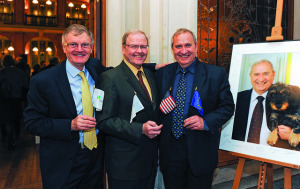ECPA’s Bocquet Speaks Out for Free Trade

Bocquet
Jean-Charles Bocquet pulls over to the side of the road to answer his phone on a spring evening in Belgium. As the days have been growing warmer he has been transitioning into his new role as director general of the European Crop Protection Association (ECPA). Even when he is out of the office he is accessible, communicative and immediately conveys openness and approachability.
“We really want to be considered a source of information and we really like when we are contacted by NGOs and journalists,” he said right away.
Bocquet is charged with leading the European crop protection industry through an inhospitable regulatory environment.
The root of the crop protection regulatory challenge in the EU lies in the precautionary principle, according to Jean-Philippe Azoulay, acting ECPA president. Encoded in the EU’s constitution, it is a rule that dictates the use of caution in regulating issues and circumstances that could endanger human, animal, plant or environmental health. Its opponents believe that it hinders progress more than it prevents harm.
Because of it, “the choice that companies are making is to invest in North America, the Asia Pacific or Latin America exponentially more than they invest in Europe,” Azoulay says.
What happens in the EU has a ripple effect, explains Howard Minigh, president and CEO of CropLife International, ECPA’s parent organization. “Many of the issues that we’re dealing with are global, and it is CropLife International’s role to put an umbrella out there for the whole global network and ensure that everyone has a seat at the table. Europe is an important geography for us,” he says. He noted that European Parliamentary elections in May and a new European Commission by the end of 2014 will present opportunities for Bocquet to educate the public servants who control the regulations.
CropLife America CEO Jay Vroom echoed that sentiment, explaining that it is a critical time for the industry. “Both the domestic regulatory and trade issues on the table are of huge significance and are increasing the opportunity for synergism between our two associations, and in partnership with the CropLife International community,” he said.
That sentiment exemplifies ECPA’s main message: Open, public dialogue with the community with the aim of growing more and better quality crops in a way that respects the environment.
Preserving nature is a familiar concept for Bocquet. The son of a forest keeper, he grew up in the French countryside, where he spent his vacations on the family farm learning to grow sugar beets, corn and wheat in hopes of one day becoming a farmer himself. He took steps to learn and implement the business aspects of farm management and, finding himself attracted to the scientific and biological aspects of the profession, went on to study agronomy engineering and specialize in crop protection.

Bocquet (left), Jay Vroom of CropLife
America (center) and Friedhelm Schmider (right). Schmider said in a farewell speech:
“I believe that it is in everyone’s interest that we recognize there is a need to stimulate an environment that looks for resources for knowledge sharing as this will be key to creating jobs for the younger generation, the future of Europe, our future.”
Now he is following in the footsteps of Dr. Friedhelm Schmider who retired as head of the organization in November 2013.
Bocquet said of Schmider, “Friedhelm had been running ECPA for more than 10 years in a great way. He will be a tough act for me to follow. He was able to launch the Hungry for Change initiative and he laid the foundation for it, so now it’s up to me and our team to work together in order to develop this project and harvest its rewards as soon as we can.”
Hungry for Change is a series of practical, educational stewardship programs that ECPA is promoting not only to protect the environment, but also help define and steer the current international regulatory climate surrounding crop protection in a less ambiguous and more favorable, productive and sustainable direction. One of the concepts behind Hungry for Change is the idea that if more stakeholders can be educated about the truth of crop protection practices, then they will be better able to make informed, intelligent decisions regarding the appropriateness of international regulations governing the import and export of crop protection products.
FCI had the opportunity to talk with Bocquet about how he wants to put
ECPA’s main message of open communication with policymakers, industry leaders and the public into action.
“This is the beauty of my job: explaining to and informing the general public and opinion leaders that our sector, our activities and our 20 member companies such as DuPont, Monsanto, Bayer, Syngenta and others are developing solutions which are useful for the general population,” he began.
Regulatory climate
FCI: Do you think that public opinion and public perception pose the biggest challenge to the crop protection industry in the current regulatory environment?
Bocquet: Yes. They pose some consequences in the short term for our reputation and the way we are perceived by people who don’t like pesticides in Europe. But the consequence of that is pressure on the policymakers, and then they make decisions which are not science-based but precautionary principle-based.
FCI: ECPA stresses science and risk assessments as the main way to move forward. How do these two concepts apply to crop protection regulation?
Bocquet: What we want is a kind of convergence between legislation on both sides of the Atlantic to be sure that the way products are evaluated and put on the market are very similar. And then we want Europe to reconsider the current trend of making decisions based only on hazards and not on risk evaluation.
So far the situation in the U.S. is that any decision is based on risk evaluation. Of course if risk is manageable, then a product can be put on the market. But that is not the case in Europe today because of some new aspects of recent regulations like the 1107/2009 regulation.
This is a regulation that has applied to all EU member states since June 2011. There are some good things about it, at least on paper. For example, if a product is getting registration in one country, then a neighboring country has 120 days to decide to give it the same registration, and that can really facilitate registration based on mutual recognition between members states.
But so far, in practice, it hasn’t really worked, and on top of that, this
regulation introduced what they call cutoff criteria. Cutoff criteria are hazard-based criteria. That means that as soon as you have products that meet those hazard specifications, you are not even allowed to go through the risk evaluation process and you get kicked out of the European market, which is not the case in the U.S.
FCI: Mr. Schmider said at his retirement party, “With new incoming members of Parliament and the Commission, we need to get together to reshape and develop the tools that will construct the regulatory backbone which will enable and support growth.” Can you provide an overview of the crop protection regulatory environment as you see it inside Europe?
Bocquet: Today the regulatory system inside Europe is really very tough and it’s going in a direction which is too hazard-based without taking into account the benefits our solutions bring for growers. It’s a shame because we don’t want to lose ground as a historically successful food producer, but today with the regulation that is in place, farmers are
being prevented from benefitting from the innovation happening and the new products coming on the market in other parts of the world.
We have developed a vision that we plan to share with Parliament and the Commission in the coming months.
This vision has five points. First, the crop protection sector must be managed based on science. Secondly, we need better and smarter regulation. Thirdly, we need regulation that is balanced against what exists in other parts of the world to avoid the anticompetitiveness of EU regulation. We have to have those three points: science-based, smarter
regulation and no discrepancy between Europe and other parts of the world. Then our fourth point, innovation, will be able to really develop, and as a consequence of that, we will be able to contribute to competitive and sustainable agriculture in Europe.
FCI: How might this regulatory environment affect regions other than the U.S. or Europe when it comes to crop protection?
Bocquet: More and more we are working together not only with our U.S. colleagues but with our colleagues in regions such as Africa, South America and Asia. Issues are global and what is going on today in Europe can also have an effect tomorrow in Africa, Asia or in the U.S.
Endocrine Disruptors
FCI: Can you discuss the endocrine disruptor issue?
Bocquet: The endocrine disruptor issue is part of this hazard-based discussion. The problem is that the European Commission was supposed to set the criteria which can cause an active substance to be considered an endocrine disruptor by December 2013. Today it is April and this has not yet been done.
The current proposals are not acceptable for us because they are based on mode of action, but not really on the potency of the active ingredient, dose, relative effects or the real effect on the whole organism. You can have an endocrine-causatory effect which in the end doesn’t affect the organism negatively.
FCI: Can you explain the difference between hazard-based assessment and risk-based assessment?
Bocquet: Hazard characterization includes factors like toxicity and other parameters of the active ingredient. Risk takes into account the exposition (modalities of use rates, number of applications) in order to respect human beings and the environment.
FCI: So, with the EU’s hazard-based specifications, you get one chance to pass the tests and that’s it?
Bocquet: In fact, we don’t get any chance at all. If you are classified as endocrine disruptor from the start, then you are excluded, which is not the case in the U.S. so far. So this is a big difference between the U.S. and Europe. You know that what you are doing in the U.S. is very safe, the food you are producing is safe and there is no reason to create extra difficulty here in Europe. For us, safety and security are also a must, but we must do that with acceptable and manageable regulation.
Outreach
FCI: ECPA places a lot of emphasis on outreach and education.
Bocquet: We have an initiative called Hungry for Change which currently consists of 12 stewardship projects plus demonstrations and training running in Europe between ECPA, our country associations and our members in order to show pragmatically how you can produce good food in a sustainable way, respecting farmer health, biodiversity, water and wildlife. So we have to show this to opinion leaders, policymakers and the media to reduce the gap between public perception and what we do collectively with our partners. We have to teach them that if farmers use pesticides properly, the exposure to the environment is acceptable.
Take a snake for example. If you find a snake in its own natural habitat, it could bite you and you could die. The hazard of the snake is very high. The exposure and the risk are very high. But the same snake in Paris, while just as dangerous, presents a smaller chance of exposure, so the
risk is acceptable. Don’t kill the snake;
control it. •
Editor’s Note: ECPA is planning an event scheduled for Dec. 2, 2014 in Belgium to promote Hungry for Change and the contribution of crop protection to sustainable and competitive agriculture.





